
Radar is a detection system that uses radio waves to determine the distance (ranging), angle, and radial velocity of objects relative to the site. It can be used to detect aircraft, ships, spacecraft, guided missiles, motor vehicles, weather formations, and terrain. A radar system consists of a transmitter producing electromagnetic waves in the radio or microwaves domain, a transmitting antenna, a receiving antenna and a receiver and processor to determine properties of the objects. Radio waves from the transmitter reflect off the objects and return to the receiver, giving information about the objects' locations and speeds.

In computer graphics and digital photography, a raster graphic represents a two-dimensional picture as a rectangular matrix or grid of square pixels, viewable via a computer display, paper, or other display medium. A raster is technically characterized by the width and height of the image in pixels and by the number of bits per pixel. Raster images are stored in image files with varying dissemination, production, generation, and acquisition formats.

Weather radar, also called weather surveillance radar (WSR) and Doppler weather radar, is a type of radar used to locate precipitation, calculate its motion, and estimate its type. Modern weather radars are mostly pulse-Doppler radars, capable of detecting the motion of rain droplets in addition to the intensity of the precipitation. Both types of data can be analyzed to determine the structure of storms and their potential to cause severe weather.
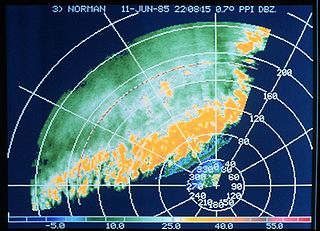
A plan position indicator (PPI) is a type of radar display that represents the radar antenna in the center of the display, with the distance from it and height above ground drawn as concentric circles. As the radar antenna rotates, a radial trace on the PPI sweeps in unison with it about the center point. It is the most common type of radar display.

The automatic identification system (AIS) is an automatic tracking system that uses transceivers on ships and is used by vessel traffic services (VTS). When satellites are used to receive AIS signatures, the term Satellite-AIS (S-AIS) is used. AIS information supplements marine radar, which continues to be the primary method of collision avoidance for water transport. Although technically and operationally distinct, the ADS-B system is analogous to AIS and performs a similar function for aircraft.

A chief mate (C/M) or chief officer, usually also synonymous with the first mate or first officer, is a licensed mariner and head of the deck department of a merchant ship. The chief mate is customarily a watchstander and is in charge of the ship's cargo and deck crew. The actual title used will vary by ship's employment, by type of ship, by nationality, and by trade: for instance, chief mate is not usually used in the Commonwealth, although chief officer and first mate are; on passenger ships, the first officer may be a separate position from that of the chief officer that is junior to the latter.
A second mate or second officer (2/O) is a licensed member of the deck department of a merchant ship holding a Second Mates Certificate of Competency, which is issued by the administration. The second mate is the third in command and a watchkeeping officer, customarily the ship's navigator. Other duties vary, but the second mate is often the medical officer and in charge of maintaining distress signaling equipment. On oil tankers, the second mate usually assists the chief mate with the Cargo operations.
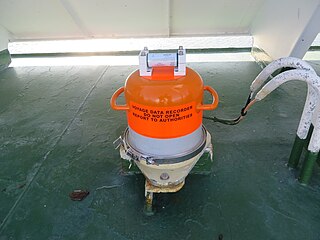
Voyage data recorder, or VDR, is a data recording system designed for all vessels required to comply with the IMO's International Convention SOLAS Requirements in order to collect data from various sensors on board the vessel. It then digitizes, compresses and stores this information in an externally mounted protective storage unit. The protective storage unit is a tamper-proof unit designed to withstand the extreme shock, impact, pressure and heat, which could be associated with a marine incident.
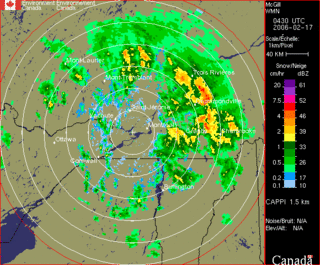
The constant altitude plan position indicator, better known as CAPPI, is a radar display which gives a horizontal cross-section of data at constant altitude. It has been developed by McGill University in Montreal by the Stormy Weather Group to circumvent some problems with the PPI:

A raster scan, or raster scanning, is the rectangular pattern of image capture and reconstruction in television. By analogy, the term is used for raster graphics, the pattern of image storage and transmission used in most computer bitmap image systems. The word raster comes from the Latin word rastrum, which is derived from radere ; see also rastrum, an instrument for drawing musical staff lines. The pattern left by the lines of a rake, when drawn straight, resembles the parallel lines of a raster: this line-by-line scanning is what creates a raster. It is a systematic process of covering the area progressively, one line at a time. Although often a great deal faster, it is similar in the most general sense to how one's gaze travels when one reads lines of text. The data to be drawn is stored in an area of memory called the refresh buffer or frame buffer. This memory area holds the values for each pixel on the screen. These values are retrieved from the refresh buffer and painted onto the screen one row at a time.
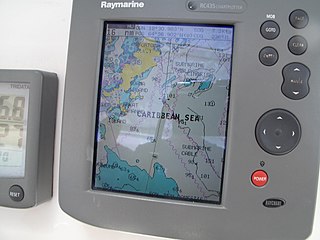
A Chartplotter is a device used in marine navigation that integrates GPS data with an electronic navigational chart (ENC).

A radar display is an electronic device to present radar data to the operator. The radar system transmits pulses or continuous waves of electromagnetic radiation, a small portion of which backscatter off targets and return to the radar system. The receiver converts all received electromagnetic radiation into a continuous electronic analog signal of varying voltage that can be converted then to a screen display.
Radar geo-warping is the adjustment of geo-referenced radar images and video data to be consistent with a geographical projection. This image warping avoids any restrictions when displaying it together with video from multiple radar sources or with other geographical data including scanned maps and satellite images which may be provided in a particular projection. There are many areas where geo warping has unique benefits:
Mini-automatic radar plotting aid is a maritime radar feature for target tracking and collision avoidance. Targets must be manually selected, but are then tracked automatically, including range, bearing, target speed, target direction (course), CPA, and TCPA, safe or dangerous indication, and proximity alarm. MARPA is a more basic form of ARPA.

The Low Flying Detection Radar also called Indian Doppler Radar (INDRA) series of 2D radars were developed by Electronics and Radar Development Establishment (LRDE), of Defence Research and Development Organisation (DRDO) for the Army and the Air Force. These were then produced by the Bharat Electronics which generally the production partner of LRDE. The INDRA-I is a mobile surveillance radar for low level target detection while the INDRA-II is for ground controlled interception of targets.

CMA CGM Medea is a container ship built in 2006.

Marine radars are X band or S band radars on ships, used to detect other ships and land obstacles, to provide bearing and distance for collision avoidance and navigation at sea. They are electronic navigation instruments that use a rotating antenna to sweep a narrow beam of microwaves around the water surface surrounding the ship to the horizon, detecting targets by microwaves reflected from them, generating a picture of the ship's surroundings on a display screen.
The Comprehensive Display System (CDS) was a command, control, and coordination system of the British Royal Navy (RN) that worked with the detection/search Type 984 radar. The system was installed on a total of six ships starting in 1957. The US Navy purchased a prototype CDS and produced twenty of their own version, the Electronic Data System (EDS). These were used on a number of ships until 1968. A modified version, the Data Handling System, was used with the AMES Type 82 radar by the Royal Air Force, and US Air Force very nearly used it as well.
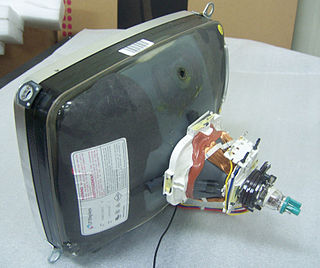
A deflection yoke is a kind of magnetic lens, used in cathode ray tubes to scan the electron beam both vertically and horizontally over the whole screen.















